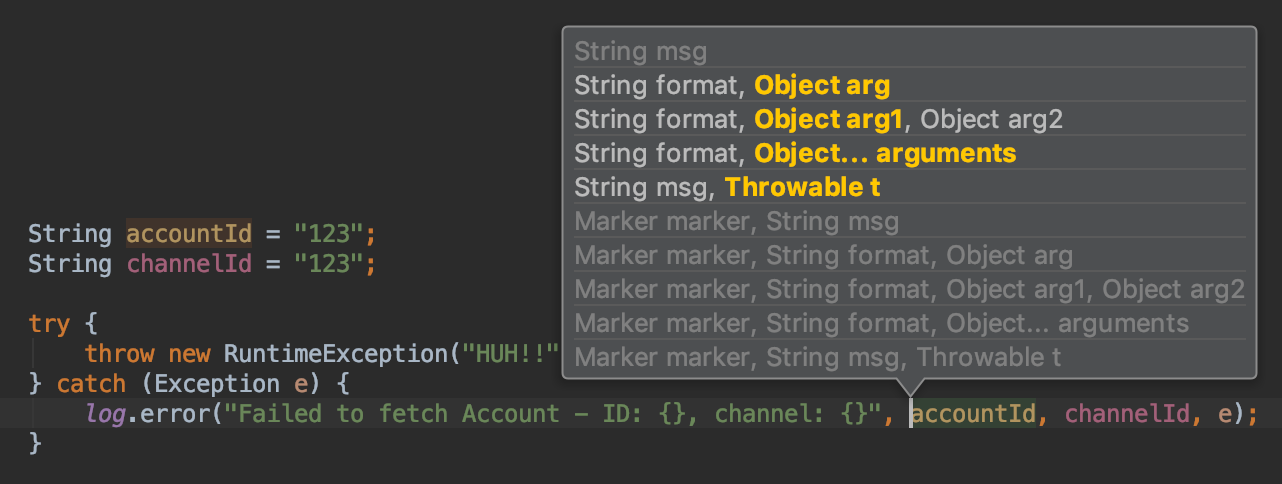[Logger] 형식화된 메시지(formatted message)를 로깅할 때 마지막 throwable(exception) 파라미터에 관해
by형식화된 메시지(formatted message) 로깅
아래 두 로깅 메시지는 똑같은 로그 메시지를 남긴다. 읽기도 쉽고 사용하기도 쉽기 때문에 아래 방법을 많이 사용한다.
try {
throw new RuntimeException("HUH!!");
} catch (Exception e) {
log.error("Failed to fetch Account - ID: " + accountId + ", channel: " + channelId, e);
log.error("Failed to fetch Account - ID: {}, channel: {}", accountId, channelId, e);
}
{}는 파라미터에서 차례로 하나씩 꺼내서 로깅 문자열 포메팅에 사용하게 된다.
[main] ERROR kr.leocat.test.logging.Test - Failed to fetch Account - ID: 123, channel: 456
java.lang.RuntimeException: HUH!!
at kr.leocat.test.logging.Test.main(Test.java:31)
[main] ERROR kr.leocat.test.logging.Test - Failed to fetch Account - ID: 123, channel: 456
java.lang.RuntimeException: HUH!!
at kr.leocat.test.logging.Test.main(Test.java:32)
더 많은/적은 개수의 파라미터
그런데, 궁금해졌다. {}는 2개인데, 파라미터를 3개, 4개 등 더 많이 주면 어떻게 될까?? 반대로 적게 1개만 주면 어떻게 될까??
try {
throw new RuntimeException("HUH!!");
} catch (Exception e) {
log.error("Failed to fetch Account - ID: {}, channel: {}", accountId, channelId, name, age, e);
log.error("Failed to fetch Account - ID: {}, channel: {}", accountId, e);
}
우선, 위처럼 {}는 2개지만 파라미터로 4개(accountId, channelId, name, age)와 예외(e)를 주면, 남는 파라미터(name, age)는 무시된다. 그리고 파라미터가 모자라는 경우는 메시지가 포메팅되지 않고 {} 그대로 로깅된다.
[main] ERROR kr.leocat.test.logging.Test - Failed to fetch Account - ID: 123, channel: 456
java.lang.RuntimeException: HUH!!
at kr.leocat.test.logging.Test.main(Test.java:31)
[main] ERROR kr.leocat.test.logging.Test - Failed to fetch Account - ID: 123, channel: {}
java.lang.RuntimeException: HUH!!
at kr.leocat.test.logging.Test.main(Test.java:32)
마지막 파라미터의 비밀 (특히, throwable)
그런데, 파라미터 개수가 부족해도 마지막에 넘겨준 예외(e)는 사용되지 않았다. 왜일까??
logger 마다 다르겠지만 오버로딩 된 메소드들을 보면, error(String msg, Throwable t) 같이 throwable을 던질 수 있는 메소드가 하나 있다. 이 메소드를 쓰면 예외의 stacktrace를 함께 남겨줘서 디버깅할 때 유용하다. 이런 습관이 다른 오버라이딩된 메소드를 쓸 때도 이어지다 보니 error(String format, Object... arguments) 같은 메소드를 쓴 때도 무의식적으로 마지막에 throwable을 넘겨주게 된다.
몇 가지 logger 소스를 받아서 따라가 보면, 메시지를 포메팅할 때 마지막 파라미터에 throwable이 있으면 뽑아내 버리는 로직이 있다.
// logback(v1.2.3) - ch.qos.logback.classic.spi.LoggingEvent
public LoggingEvent(String fqcn, Logger logger, Level level, String message, Throwable throwable, Object[] argArray) {
// .. 생략
if (throwable == null) {
throwable = extractThrowableAnRearrangeArguments(argArray);
}
if (throwable != null) {
this.throwableProxy = new ThrowableProxy(throwable);
LoggerContext lc = logger.getLoggerContext();
if (lc.isPackagingDataEnabled()) {
this.throwableProxy.calculatePackagingData();
}
}
timeStamp = System.currentTimeMillis();
}
// slf4j(v1.7.20) - org.slf4j.helpers.MessageFormatter#arrayFormat(java.lang.String, java.lang.Object[])
final public static FormattingTuple arrayFormat(final String messagePattern, final Object[] argArray) {
Throwable throwableCandidate = getThrowableCandidate(argArray);
Object[] args = argArray;
if (throwableCandidate != null) {
args = trimmedCopy(argArray);
}
return arrayFormat(messagePattern, args, throwableCandidate);
}
logback에서는 LoggingEvent를 만들 때 extractThrowableAnRearrangeArguments() 메소드에서, slf4j는 로깅할 메시지인 FormattingTuple를 만들 때 getThrowableCandidate() 메소드에서 throwable을 꺼낸다. 두 구현체의 같은 점은 마지막 파라미터만 throwable인지 체크해서 뽑는다는 것이다.
결론
파라미터에서 마지막 throwable을 뽑아내서 stacktrace를 찍어줄지는 구현체 마다 다르겠지만, 많은 구현체에서 구현하고 있으니 편하게 쓸 수 있겠다. (그래도 진짜 되는 구현체인지 한번 확인은;;)
log.error("Failed to fetch Account - ID: {}", accountId, e);

